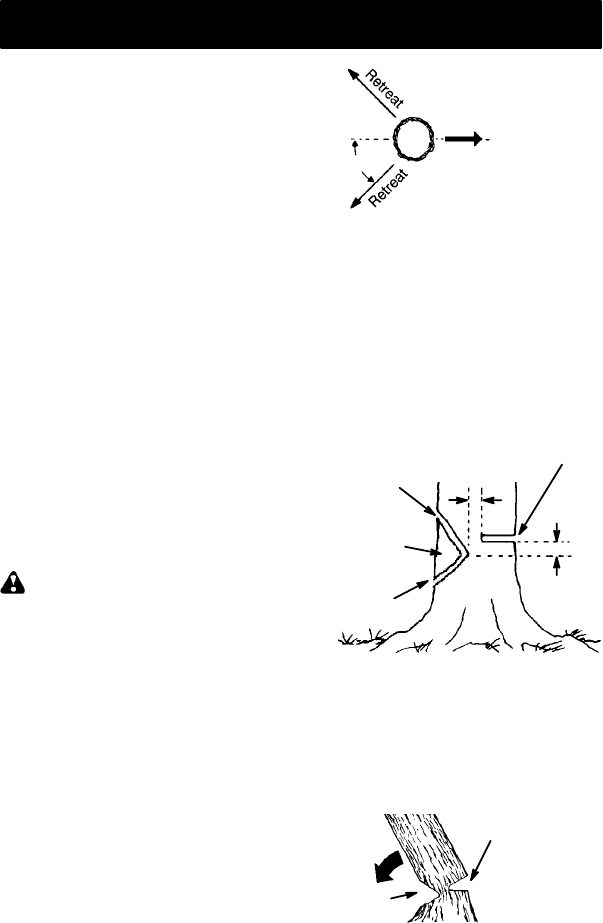
10
CUTTING METHODS
IMPORTANT POINTS
S Check chain tension before first use and af-
ter 1minute of operation. See CHAIN TEN-
SION in the ASSEMBLY section.
S Cut wood only. Do not cut metal, plastics,
masonry , no n-wood b uildin g mat erials, etc.
S Stop thesaw if the chainstrikesa foreignob-
ject. Inspectthe saw andrepairparts asnec-
essary.
S Keepthechainoutofdirtandsand. Evena
smallamountofdirtwillquicklydullachain
and increase the possibility of kickback.
S Practice cutting afew smalllogs usingthe
followingtechniques togetthe“feel”ofus-
ing your saw before you begin a major
sawing op eration.
S Squeeze thethrottle trigger and allowthe
engine to reach full speed before cutting.
S Begin cutting w i th the saw frame
against the log.
S Keeptheengine at fullspeedthe entire
time you a re cutting.
S Allowthechaintocutforyou.Exertonly
light downward pressure.
S Release the throttle trigger as soon as
the cut is completed, allowing the en-
gine to idle. If you run the saw at full
throttlewithoutacuttingload,unneces-
sary wear can occur.
S Toavoidlosingcontrolwhencutiscom-
plete,d onotputpressureonsawatend
of cut.
S Stoptheenginebeforesettingthe sawdown.
TREE FELLING TECHNIQUES
WARNING:Donotcutnearbuildings
or electrical wires if you do not know the di-
rection of tree fall, at night since you will not
be able to see well, or during bad weather
suchas rain,snow,orstrong winds.as fallis
unpredictable.
Carefully plan your sawing operation in ad-
vance. You need aclear area all around the
treeso you can have secure footing. Check
for broken or dead branches which can fall
on you causing serious injury.
Natural conditions that can cause a tree to
fall in a particular direction include:
S The wind direction and speed.
S The lean of the tree. The lean of a tree
might not be apparent due to uneven or
slopingterrain. Useaplumborleveltode-
termine the direction of tree lean.
S Weight and branches on one side.
S Surrounding trees and obstacles.
Look for decay and rot. If thetrunk isrotted,
it can snap and fall toward the operator.
Make sure there is enough room for the treeto
fall. Maintain a distance of
2-1/2 tree lengths
from the nearest person or other objects. En-
gine noise can drown out a warning call.
Remove dirt, stones, loose bark, nails, sta-
ples,andwirefromthetreewherecutsareto
be made.
Direction of Fall
45_
Plan a clear retreat path
FELLING LARGE TREES
(15cmindiameterorlarger)
The notch method is used to felllarge trees.
Anotchiscutonthesideofthetreeinthede-
sired direction of fall. After a felling cut is
made on the opposite side of tree, the tree
will tend to fall into the notch.
NOTCH CUT AND FELLING THE
TREE
S Make notch cut by cutting the top of the
notch first. Cut through
1/3of thediameter
ofthetree.Nextcompletethenotchbycut-
ting the bottom of the notch. See illustra-
tion. Once the notch is cut remove the
notch of wood from the tree.
Notch
First cut
Second cut
Final cut here. 5 cm above
center of notch.
5cm
5cm
S After removing the wood from the notch,
make the felling cut on the opposite side of
thenotch.Thisis donebymakingacutabout
two inches higher than the center of the
notch. This will leave enough uncut wood
between thefelling cut and the notch toform
a hinge. This h inge will help prevent thetree
from falling in the wrong direction.
Opening
of felling
cut
Closing
of notch
Hinge holds tree on stump and helps
control fall
NOTE: Before felling cut is complete, use
wedges to open the cut when necessary to
controlthedirectionoffall. Toavoidkickback
or chain damage, use wood or plastic
wedges, but never steel or iron wedges.
S Bealerttosignsthatthetreeisreadytofall:
cracking sounds, widening of the felling cut,
or movement in the upper branches.


















